#Myricaceae
Explore tagged Tumblr posts
Text
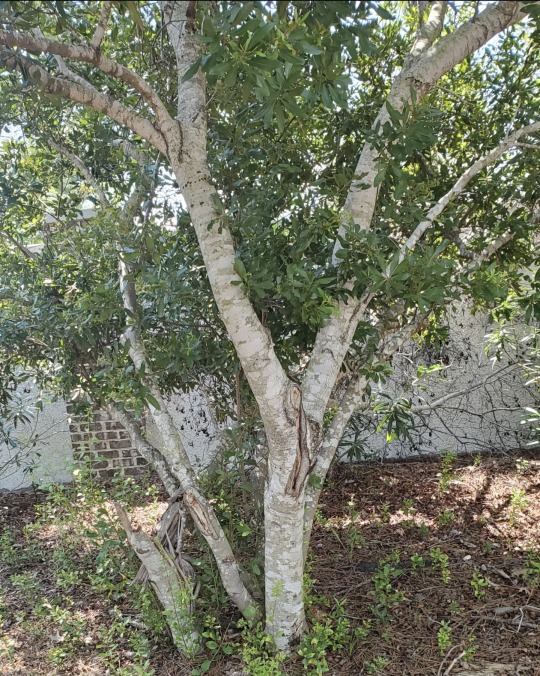
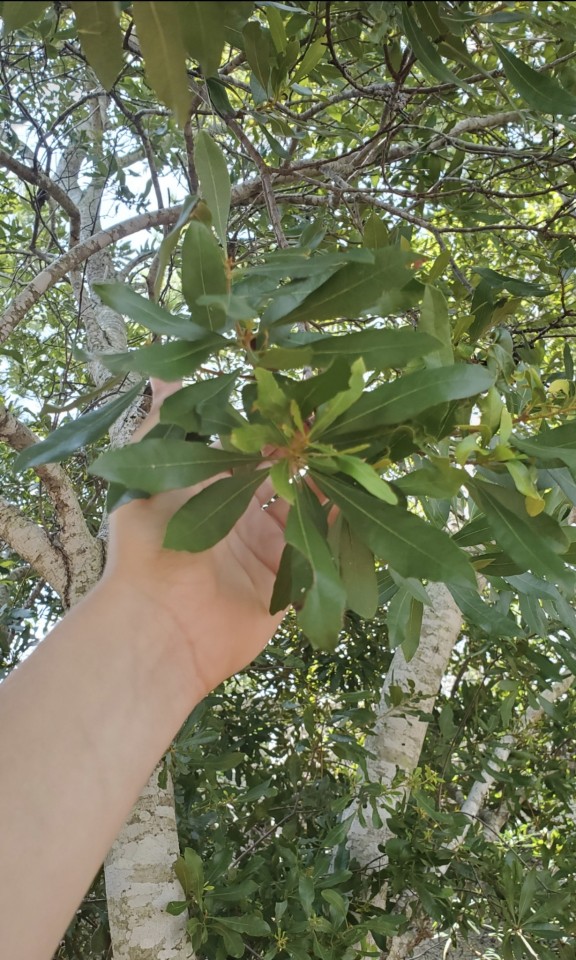
8/12/2023
1 note
·
View note
Text
This guy is Morella californica, in the MYRICACEAE family. It is commonly known as Pacific bayberry or California wax-myrtle!
This evergreen shrub can be identified by its alternate, lanceolate leaves that extend from all sides of the branch, appearing almost whorled. They have a waxy texture and are slightly crenate/serrated. Its flowers are red when young and occur in rounded clusters at the ends of branches and in leaf axils. It produces purple-black drupes.
Morella californica is native to the West Coast of North America in moist, low elevation forests. Its waxy leaves provide protection against drought and herbivory. It has the ability to resprout from its root crown, allowing for tolerance to fire. It hosts nitrogen fixing bateria in its root nodules, improving its wellbeing in low nutrient conditions.




0 notes
Photo

Northern Bayberry, Myrica pensylvanica (by me)
#Northern Bayberry#Myrica pensylvanica#Myrica#Myricaceae#Fagales#plants#shrub#berries#summer#Cheesequake State Park#Middlesex County#New Jersey#mine
15 notes
·
View notes
Photo
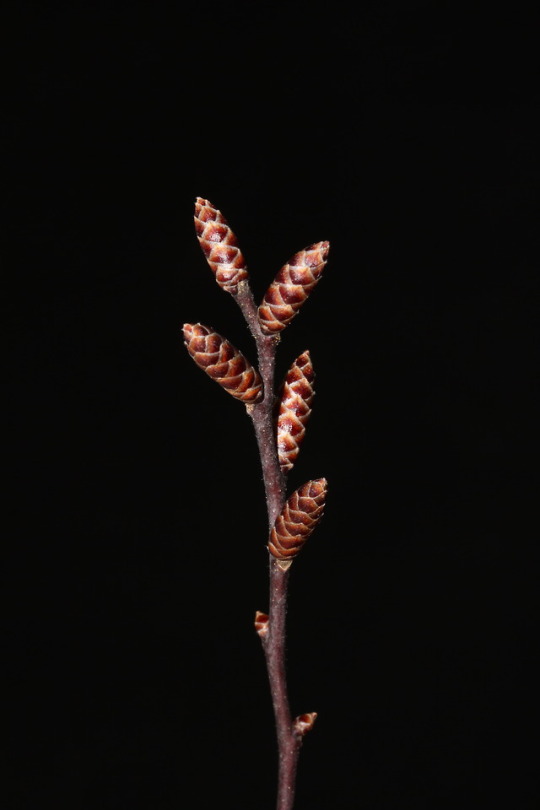
I’ve been reunited with Sweetgale (Myrica gale) after moving back to northern Michigan and I don’t think I’ll ever get tired of sniffing the buds
5 notes
·
View notes
Photo




Myrica pensylvanica / Northern Bayberry
Family: Myricaceae
Native: Eastern North America
Mature Size: 5-10ft height, 5-10ft spread
Habitat: average, well-drained soil; sandy soils and coastal conditions;
Hardiness Zone: 3-7
Leaf Color: leathery, glossy, grayish-green leaves and are dotted with resin
Flower color/Bloom time: Yellowish-green; May
Enclosure:
The Northern Bayberry is a dense-branching and rounded plant. The density of the branching leaves a full inner tree system without any space for a natural enclosure. Additionally, due to its general habitat in coastal dunes, the bayberry can be partially buried by sand at times, further reducing any minimal inhabitable enclosure. The maturity dimensions of the Northern Bayberry is unable to support any structure, however due to the density of branches and the thickness of leaves, this could make for a decent shade canopy, especially at the beach where this plant can be found.
Sources:
Go Botany https://gobotany.nativeplanttrust.org/plantshare/questions/all/2017/#q1625
Missouri Botanical Garden http://www.missouribotanicalgarden.org/PlantFinder/PlantFinderDetails.aspx?kempercode=e310
North Carolina Plant Toolbox https://plants.ces.ncsu.edu/plants/myrica-pensylvanica/
Plants for a Future https://pfaf.org/user/Plant.aspx?LatinName=Myrica+pensylvanica
0 notes
Text




Comptonia peregrina | Sweetfern
Plant Community: Barrier Beach
Type: Deciduous shrub
Family: Myricaceae
Native Status: Eastern North America; Native
Mature Size: Height 2′ - 5′ | Spread 4′ - 8′
Habitat / Conditions: Easily grown in average, medium, well-drained soil in full sun to part shade. Adaptable plant that tolerates wet conditions and wind (including sheltered seashore areas), drought and a wide range of soils (prefers sandy, acidic loams, but tolerates poor soils). Does not transplant well. Once established, however, it can spread rapidly to form colonies.
Hardiness Zone: 2 - 6
Leaf Color: Green
Flower Color / Bloom Time: Yellowish-Green | April - May
Medicinal Properties:
Sweet fern was employed medicinally by several native North American Indian tribes who used it especially as a poultice to treat a variety of complaints. It is still used for most of the same purposes in modern herbalism. The leaves are astringent, blood purifier, expectorant and tonic. A tea made from the leaves and flowering tops is used as a remedy for diarrhea, headache, fevers, catarrh, vomiting of blood, rheumatism etc. The infusion has also been used to treat ringworm. The leaves have also been used as a poultice for toothaches, sprains etc. A cold water infusion of the leaves has been used externally to counter the effect of poison ivy and to bathe stings, minor hemorrhages etc. The leaves are harvested in early summer and dried for later use.
Sources:
http://www.missouribotanicalgarden.org/PlantFinder/PlantFinderDetails.aspx?kempercode=c240
https://pfaf.org/user/plant.aspx?LatinName=Comptonia+peregrina
https://www.fs.fed.us/database/feis/plants/shrub/comper/all.html#DISTRIBUTION%20AND%20OCCURRENCE
#Barrier Beach#Deciduous shrub#Myricaceae#eastern north america#astringent#expectorant#Antipyretic#ondontalgic#antiparasitic#tonic
0 notes
Text
Comptonia peregrina

Comptonia peregrina
Common Name: Sweet Fern
Sweet ferns are not true ferns, they are in the Wax-Myrtle Bayberry Family (Myricaceae). They are native to the Eastern United States and Canada. They are very tolerant plants with nitrogen-fixing abilities and are used as ground cover for erosion control in sandy, sterile soils (sometimes you can find them along rural roadsides).
This sweet fern was found growing on a sunny, south-facing hillside in a small colony of its species. These shrubs appear to reach a maximum height of about 3.5 to 4 feet with a branching structure (see photos). Its leaves are leathery, elongated and lobed. What is most noticeable is the fragrance of the leaves (it reminds me of Old Spice).
Sweet ferns are partially edible and have some uses traditional herbal medicine. The dried leaves can be used to make tea or a seasoning, and young berries can be eaten. It has been reported that the leaves can help repel insects when crushed or burnt. (pfaf.org)
Although not a significant plant to wildlife, sweet ferns are a larval host to the Gray Hairstreak butterfly. (wildflower.org)
Growing Preferences:
Partial Shade (appears to tolerate full sun)
Dry, well-draining soil (sandy, acidic soils)
Hardy from USDA zones 3 through 6
These photos were taken in Dunbarton, New Hampshire



Websites referenced:
https://www.wildflower.org/plants/result.php?id_plant=cope80
https://plants.usda.gov/core/profile?symbol=cope80
https://plants.usda.gov/factsheet/pdf/fs_cope80.pdf
https://pfaf.org/user/Plant.aspx?LatinName=Comptonia+peregrina#:~:text=Sweet%20fern%20was%20employed%20medicinally,62%2C%20222%2C%20257%5D.
1 note
·
View note
Text
Comptonia peregrina (Sweet fern), Myricaceae
Comptonia peregrina (Sweet fern)
Family: Myricaceae
Note: this is not a fern! It sort of looks like one, but it’s not! And that’s why common names are sometimes not helpful.

(Photo by Arthur Haines, from GoBotany)
From GoBotany: “One sniff of the pungent, turpentine-like aroma given off by the crushed leaves of this 3-foot (1m) tall shrub, and its common name, sweet-fern, will become clear. Sweetfern fixes nitrogen through a close partnership with bacteria; thus, this plant is among the first to colonize barren, nutrient-poor soils.”
This is a dry area plant. I’ve seen this as an ornamental plant in public spaces, too. If you find a sweet fern, crush a leaf and smell it, it’s really nice!
Anyway, here’s my doodle for learning the plant name.
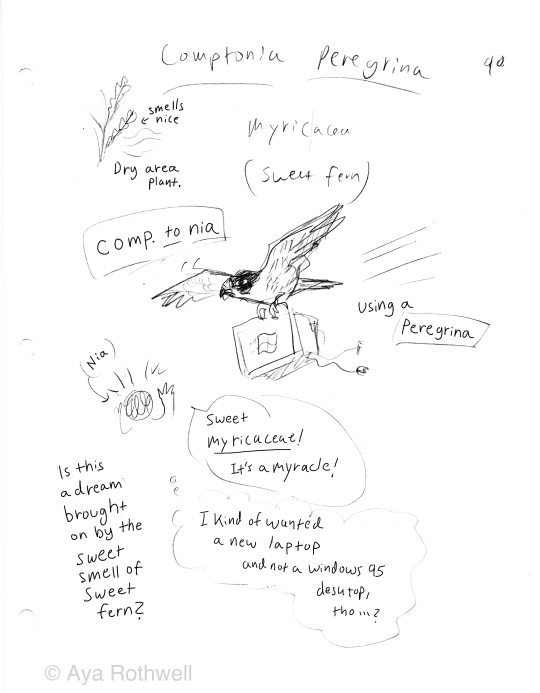
0 notes
Text
Cây Thanh Mai - kỹ thuật trồng cây thanh mai mang lại giá trị kinh tế cao cho người trồng
Cây Thanh Mai còn được gọi với tên khác là dâu rừng, vài năm trở lại cây loại cây này được nhiều người săn tìm để trồng bởi nhiều lợi ích mà quả của nó mang lại. Quả Thanh Mai có vị ngọt, chua, mát đặc trưng vì vậy mà các sản phẩm chế biến từ quả Thanh Mai được rất nhiều người ưa thích. Cây Thanh Mai còn gọi là cây Dâu rượu, loài cây này thuộc họ Dâu rượu (Myricaceae). Đây là loài thực vật bản địa ở các vùng: Ấn Độ, Trung Quốc, Nepal, Thái Lan, Bhutan, Việt Nam. Ngoài ra, cây Thanh Mai cũng được trồng nhiều ở Nhật Bản và các nước Đông Nam Á. Ở Việt Nam, cây Thanh Mai chủ yếu có 1 chi với hai loài là Myrica esculenta Buch và Myrica rubra Sieb chủ yếu m��c tự nhiên trong các khu rừng. Cây Thanh Mai phát triển tốt ở trên những sườn núi dốc với độ cao 1.500m – 3.500m so với mực nước biển. Vì vậy cây Thanh Mai là loài cây phân bố tự nhiên chủ yếu ở các tỉnh phía Bắc, một số tỉnh miền Trung nước ta như ở Sapa, Quảng Ninh…. Vậy nguồn gốc, đặc điểm và cách trồng loại cây này như thế nào? Hãy cùng nhà vườn Ngọc Lâm tìm hiểu qua bài viết dưới đây! https://nhavuonngoclam.com/cay-thanh-mai/ #nhavuonngoclam #caythanhmai Thông tin liên hệ Số điện thoại: 0968750386 Gmail: [email protected] Địa chỉ: Phố Nguyễn Mậu Tài - Trâu Quỳ - Gia Lâm - Hà Nội
0 notes
Photo


https://www.yuvikaherbs.com/
Kaiphal Powder
Myrica esculenta (Myricaceae) commonly known as box berry or kaphal is an important Indian medicinal plant. It is found in foothill tracks of Eastern Himalayas, Meghalaya, Nepal, China and Pakistan. Local tribes mainly use its fruits to prepare pickle and refreshing drinks. Traditionally, the bark has been used for the treatment of cough, asthma, fever, chronic bronchitis, diarrhoea, rheumatism and inflammation; roots have been used in bronchitis, asthma, cholera and flowers claimed to treat earache, diarrhoea, paralysis. Phytochemical studies of the different parts of plant revealed the presence of various bioactive phytoconstituents such as phenolic compounds, alkaloids, glycosides, triterpenoids and volatile oils. The plant is also reported to have innumerable significant pharmacological activities like analgesic, anxiolytic, antiallergic, antidiabetic, antimicrobial, antihypertensive, antiulcer, antioxidant and antiinflammatory evaluated by using various animal models. The objective of the present review article is to compile all the relevant published information regarding traditional uses, phytochemistry and therapeutic potential of M. esculenta. For this purpose various databases and books were examined. The review clearly demonstrates the importance of this plant in ethnomedicine and its immense potential in modern medicine.
0 notes
Text
0 notes
Photo
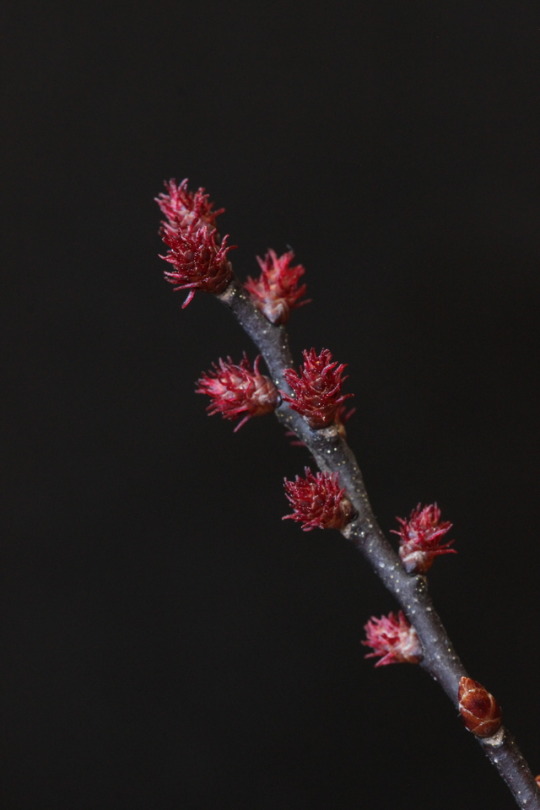
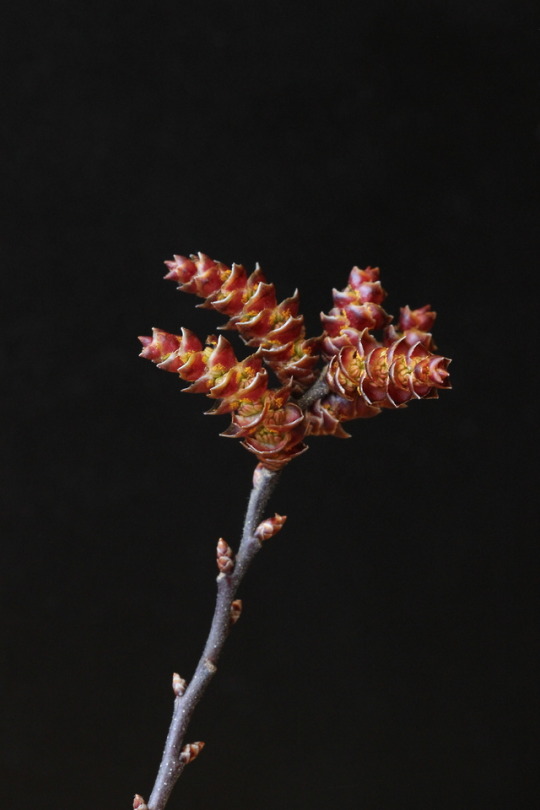
Sweetgale (Myrica gale) Female catkins on the left, male on the right Emmet County, Michigan
0 notes
Photo







Prairie Chicken
https://www.allaboutbirds.org/guide/assets/photo/70601341-480px.jpg
Sweetfern Comptonia peregrina
Family:
Myricaceae
Plant Community:
Old Field
Regions:
Native to Eastern North America
Mature Size:
Height: 2′ to 5′
Width: 4′ to 8′
Habitat:
Commonly found along roadsides and in areas with poor soils. Prefers sandy, acidic loam, but very tolerant to a wide range of soil types. Tolerant to both wet and dry conditions. Can spread rapidly in poor soils.
Hardiness Zone:
2 to 6
Leaf Color:
Summer - Dark green and shiny
Fall - No fall color
Flowers:
Color - Yellow/green
Bloom - April, May
Nesting:
Birds:
Comptonia peregrina provides cover for the nests of some bird species.
Nesters - Prarie Chicken, Sharp-tailed Grouse, Ruffed Grouse
Mammals:
Comptonia peregrina provides cover for Cottontail Rabbits and other small mammals.
Insects:
Gray Hairstreak Butterfly - Adults lay a single egg on the flower. Caterpillars eat the flower.
Sources:
http://www.missouribotanicalgarden.org/PlantFinder/PlantFinderDetails.aspx?kempercode=c240
https://www.wildflower.org/plants/result.php?id_plant=cope80
https://www.butterfliesandmoths.org/species/Strymon-melinus
https://www.fs.fed.us/database/feis/plants/shrub/comper/all.html
#larval host#insects#mammals#birds#nests#cover#caterpillar#butterfly#prarie chicken#Sharp-tailed Grouse#ruffed grouse#cottontail rabbit#gray hairstreak
0 notes
Photo






Comptonia peregrina / Sweetfern
Family: Myricaceae
Native: Eastern North America
Mature Size: 2-5ft height, 4-8ft spread
Habitat: poor, sandy or gravelly, infertile soils, such as along roadsides; grasslands, meadows, woodlands;
Hardiness Zone: 2-6
Leaf Color: simple, narrow, lustrous, pinnatifid, deeply notched, olive to dark green leaves
Flower color/Bloom time: yellowish-green; April to May
Enclosure:
A single Sweetfern bush on its own is not large enough to be a natural plant enclosure or support a human made structure. However, Sweetfern is known for it’s quick colonization growth skills, meaning that it is common in natural settings to see dense groupings of the bush together. It is in a grouping like this where a person could lie down on the ground and hide themselves - snugly - among the ferns, as a sleeping space or a sense of natural enclosure. The thickness of the leaves are sturdy and would offer minor protection from the exposed elements.
Sources:
Go Botany https://gobotany.nativeplanttrust.org/species/comptonia/peregrina/
Missouri Botanical Garden http://www.missouribotanicalgarden.org/PlantFinder/PlantFinderDetails.aspx?kempercode=c240
North Carolina Plant Toolbox https://plants.ces.ncsu.edu/plants/comptonia-peregrina/
Plants for a Future https://pfaf.org/user/plant.aspx?LatinName=Comptonia+peregrina
Lady Bird Johnson Wildflower Center https://www.wildflower.org/plants/result.php?id_plant=COPE80
#myricaceae#zone2#zone3#zone4#zone5#zone6#Sleeping Space#Enclosure by Plant#North America Native#Oldfield
0 notes
Text






Myrica pensylvanica | Northern Bayberry
Plant Community: NE Barrier Beach
Type: Deciduous shrub
Family: Myricaceae
Native Status: Eastern North America; Native
Mature Size: Height 5′ - 10 | Spread 5′ - 10′
Habitat / Conditions: Bayberry native to North America where it is primarily found growing along the eastern coast (including seashore) from Newfoundland to North Carolina. Easily grown in average, dry to medium, well-drained soils in full sun to part shade. Prefers moist, peaty or sandy, acidic soils, but tolerates a wide range of soils and growing conditions, including poor soils, wet soils, drought, high winds and salt spray (seashore or road salt conditions).
Hardiness Zone: 3 - 7
Leaf Color: Green --> multicolor green / orange / plum
Flower Color / Bloom Time: Yellowish green (male) | May
Medicinal Properties: The root bark is astringent and emetic in large doses. A tea made from the leaves is used in the treatment of fevers and externally as a wash for itchy skin.
Modern:
Modern research studies have confirmed that bayberry does contain astringent and antibacterial substances. The astringent effect is due to the tannin found in the plant and explains why the herbs was once a popular remedy for diarrhea, sores, and hemorrhoids (tannin is also know to curb intestinal inflammation).
Laboratory experiments have shown that the flavonoid myricitrin can stimulate bile flow, a trait which sometimes can be useful for ailments related to the liver and gallbladder.
The root bark is usually collected in the fall, then thoroughly dried, pulverized and stored in sealed containers that are kept away from light.
Historic:
The European settlers who came to North America learned about the medicinal properties of bayberry from the Native Americans.
A description from 1737 states that the plant “removes air and relieves all kinds of pain caused by cold, and is a good remedy for colic, paralysis, convulsions, epilepsy and other disorders.”
Sources:
http://www.missouribotanicalgarden.org/PlantFinder/PlantFinderDetails.aspx?kempercode=e310
http://www.naturalmedicinalherbs.net/herbs/m/myrica-pensylvanica=northern-bayberry.php
https://www.herbal-supplement-resource.com/bayberry-herb.html
0 notes
Text
Myrica pensylvanica



Bayberry
Botanical name: Myrica pensylvanica All Common Names: Bayberry, Northern Bayberry, Candleberry Family (English): Bayberry Family (Botanic): Myricaceae Tree or Plant Type: Shrub Foliage: Evergreen (foliage year-round) Native Locale: North America Landscape Uses: Hedge, Massing, Mixed border, Screen, Shade tree Size Range: Large shrub (more than 8 feet), Medium shrub (5-8 feet) Light Exposure: Full sun (6 hrs direct light daily), Partial sun/shade (4-6 hrs light daily) Hardiness Zones: Zone 3, Zone 4, Zone 5 (Chicago), Zone 6, Zone 7
BUILD/BEAUTY
The bayberry is an attractive shrub that produces these waxy small blue berries that can be cultivated for candles scented like bayberry. The fruiting bodies are great for the local ecology, many species enjoy eating them I personally would not put this plant in a landscape, it looks too similar to a rhododendron. The bark gets a 0 because it is too small, the leaves will get a 2 due to the local fruiting bodies, and the landscape uniqueness will get a 1 out of 3. This compounds for a score of 3 out of 10.
Bark: (1-3) 0
Leaves: (1-4) 2
Landscape uniqueness: (1-3) 1
Beauty score: 3 out of 10
For building materials, this shrub does not contribute in any way to a structural or useful member. This shrub gets a 0 out of 10 for build quality. The most use it has is its wax for candles.
Source:
1. https://www.mortonarb.org/trees-plants/tree-plant-descriptions/bayberry
2. http://www.missouribotanicalgarden.org/PlantFinder/PlantFinderDetails.aspx?kempercode=e310
3. https://macphailwoods.org/nature-guides/shrubs/bayberry/
0 notes